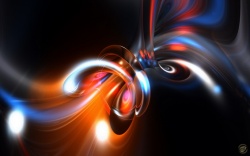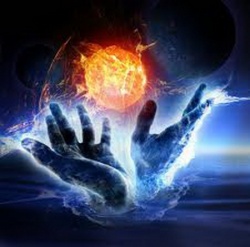Yantra
Yantra (यन्त्र) is the Sanskrit word for "instrument" or "machine". Much like the word "instrument" itself, it can stand for symbols, processes, automata, machinery or anything that has structure and organization, depending on context.
One usage popular in the west is as symbols or geometric figures. Traditionally such symbols are used in Eastern mysticism to balance the mind or focus it on spiritual concepts. The act of wearing, depicting, enacting and/or concentrating on a yantra is held to have spiritual or astrological or magical benefits in the Tantric traditions of the Indian religions.
Stella Kramrisch defined a yantra as "a geometrical contrivance by which any aspect of the Supreme Principle may be bound to any spot for the purpose of worship. It is an artifice in which the ground is converted into the extent of the manifest universe." According to Heinrich Zimmer: “The yantra is so named because it brings about the vanquishment (niyantrana) of all evil that arises from desire, anger, and other errors. Hence one should draw an auspicious yantra along with the surrounding frame and develop it before one’s inner eye, once one has learned everything useful to know about it from the mouth of the teacher.”
Etymology and meanings
Yantra is a Sanskrit word that is derived from the root yam meaning to control or subdue or "to restrain, curb, check". Meanings for the noun derived from this root include:
- "any instrument or machine" (i.e. that which is controlled or controls. For instance the body is said to be a yantra)
- "any instrument for holding, restraining, or fastening" (for instance a symbol which 'holds' the essence of a concept, or helps the mind to 'fasten' on a particular idea)
- "a mystical or astronomical diagram" (usually a symbol, often inscribed on an amulet) sometimes said to possess mystical or magical powers.
-tra is an indoeuropean suffix meaning ' instrument', found in Latin aratrum and in tantra and mantra. A yantra depicts both macrocosmic and microcosmic forces acting together - the movement towards and away from the centre - "control" and "liberation" within the one device. Mantra plus yantra creates tantra. In some disciplines of Tantra it is said that a focused, controlled gaze upon a particular yantra may lead to liberation.
Symbols employed in yantras
Shapes and patterns commonly employed in yantra include squares, triangles, circles and floral patterns but may also include more complex and detailed symbols, for instance:
- The lotus flower typically represents chakras, with each petal representing a psychic propensity (or vritti) associated with that chakra;
- A dot, or bindu, represents the starting point of creation or the infinite, unexpressed cosmos;
- The shatkona (şaţkoņa) (Sanskrit name for a Hexagram) is composed of a balance between:
- An upwards triangle which according to Tantra denotes energy, or more specifically action and service (seva). It may also denote spiritual aspiration, the element of fire, or Shiva. It is also said to represent the static substratum of the cosmos;
- A downwards triangle which according to Tantra denotes spiritual knowledge. It may also denote the creative power of the cosmos, fecundity, the element of water, or Shakti;
- A swastika represents good luck, welfare, prosperity or spiritual victory;
- Bija mantras (usually represented as characters of Devanāgarī that correspond to the acoustic roots of a particular chakra or vritti).
Geometric element meanings:
- Circle = Energy of the element water
- Square = Energy of the element earth
- Upward-facing Triangle = Energy of the element fire; energy
- Downward-facing Triangle = Energy of the element water; knowledge
- Diagonal line = Energy of the element air
- Horizontal line = Energy of the element water
- Vertical line = Energy of the element fire
- Point = Energy of the element ether
As an astrological device
Yantra may be used to represent the astronomical position of the planets over a given date and time. It is considered auspicious in Hindu mythology. These yantras are made up on various objects i.e. Paper, Precious stones, Metal Plates and alloys. It is believed that constantly concentrating on the representation helps to build fortunes, as planets have their peculiar gravity which governs basic emotions and karma. These yantras are often made on a particular date and time according to procedures defined in the vedas.
Philosophical context
Yantra function as revelatory conduits of cosmic truths. Yantra, as instrument and spiritual technology, may be appropriately envisioned as prototypical and esoteric concept mapping machines or conceptual looms. Certain yantra are held to embody the energetic signatures of, for example, the Universe, consciousness, ishta-devata. Though often rendered in two dimensions through art, yantra are conceived and conceptualised by practitioners as multi-dimensional sacred architecture and in this quality are identical with their correlate the mandala. Meditation and trance induction that generates the yantra of the subtle body in the complementary modes of the utpatti-krama and saṃpanna-krama are invested in the various lineages of tantric transmission as exterior and interior sacred architecture that potentiate the accretion and manifestation of siddhi.
Madhu Khanna (2003: p. 21) in linking Mantra, Yantra, Ishta-devata, and thoughtforms states:
- Mantras, the Sanskrit syllables inscribed on yantras, are essentially "thought forms" representing divinities or cosmic powers, which exert their influence by means of sound-vibrations.


